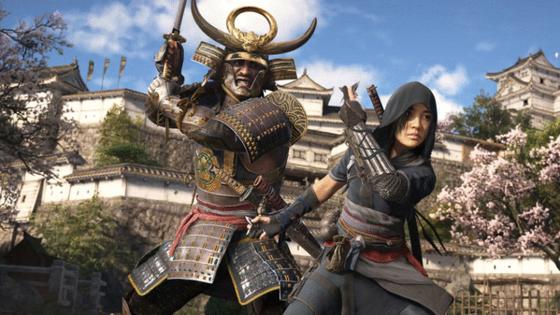'Assassin’s Creed Shadows' review: Ubisoft’s latest fails to shine
Published in Science & Technology News
"Assassin’s Creed Shadows" is a tale of two … everything, really: two main characters, two overlapping narratives and two distinct feelings as you slink and slash your way across nearly 40 hours in late 16th-century Japan. One of those feelings is elation; when Shadows shines, it’s blinding. The other, the one you’ll be feeling far more often? Well, let’s take the reference one step further: “It was the best of times, it was the worst of times.”
"Assassin’s Creed Shadows," developed by Ubisoft Quebec and published by parent company Ubisoft, is the 14th major installment in the long-running series (the first was released in 2007). Sadly, the franchise is still going through growing pains (or are those death rattles I hear?). After a delightful return to its roots in 2023’s "Assassin’s Creed Mirage" — a smaller, denser world to explore; a tighter focus on stealth and assassinations; a pivot away from the unnecessary role-playing elements that had infused the past several releases — Ubisoft has changed course once again, with "Shadows" having a little bit of everything but generally failing to excel at anything.
Its story continues to advance the series’ overarching conflict between the liberty-loving Assassin Brotherhood and control-seeking Templar Order while focusing on just one small moment in history. This time, it’s set at the end of Japan’s Sengoku period, a time of intense social upheaval and civil wars. Instead of one primary playable character, Shadows has you controlling two: the shinobi Naoe and the Black samurai Yasuke (the mention of his race is important; more on that in a moment). Each has their own narrative path to follow — Naoe, retribution; Yasuke, understanding — but they eventually intertwine as they deal with corruption, greed and the destruction caused by the power-hungry and immoral. It’s a regrettably lackluster story of violent revenge that takes few risks, even if some moments (like the side character-specific side missions) absolutely dazzle.
Each character serves a different function. The “assassin” part of the game’s title is handled mostly by Naoe, who wields the series’ recognizable hidden blade and is trained to use the shadows to her advantage. Her tool kit is built around stealth, though she does have ways of defending herself. Yasuke, meanwhile, forgoes the quiet route for a more direct approach, utilizing more powerful weapons and his physicality to defeat groups of enemies single-handedly. (You can generally swap between the characters on the fly after they meet each other for the first time; it pays to do so when the situation calls for it.)
But speaking of Yasuke: When the game’s first trailer was revealed and showed a Black samurai as a protagonist, trolls accused Ubisoft of going “woke,” despite the fact that the game character was based on the real-life Yasuke, who was a samurai of African descent in Japan during the late Sengoku period. The outrage was all sound and fury; for all of Shadows’ flaws, its inclusion and portrayal of Yasuke is not one of them.
But here’s something that should irk you: the sheer size of the map, especially considering how little there is to do. The world is mostly bereft of collectibles and worthwhile side areas to explore — you can only pray at so many temples or get lost in so many caves before it begins to bleed together. It feels counterintuitive: If you’re going to make such an enormous world, then make it enjoyable to explore. What you will find most of the time is new gear for your characters and building material for your hideout, where you can upgrade your equipment and allies.
The more frustrating part is that you have to take the time to traverse the world if you want to gain new abilities beyond the first layer of the skill tree. Mastery Points, which come at you quick in this game, are needed to buy the skills, but Knowledge Points, which are much rarer and scattered around the world, are needed to unlock them in the first place.
A high point for "Shadows" is, appropriately enough, visuals. Gameplay, particularly stealth, is influenced by an area’s brightness; the darker it is, the harder it is to see the player. The game’s seasonal system also influences gameplay, with fall’s rain and winter’s snow affecting movement and sound. (I didn’t like that I slid on the ice, but it was cool that I did.) Shadows is lovely to look at, especially when you get some high-altitude vistas. It’s just a shame that the main mode of traversing this massive world, a horse, is an absolute nightmare. You’re better off sticking to your own two feet.
After the dismal response to Ubisoft’s last major release, 2024’s "Star Wars Outlaws," the company needs a major win. I don’t think "Assassin’s Creed Shadows" is going to be that win. There are a few moments of creative wonder: a satisfying conclusion to an ally’s story, a heartbreaking trip down memory lane, a gorgeous sunset seen from on high. The rest, though? Utterly forgettable. For a franchise that deals with memory and legacy, you don’t want to be remembered for that.
———
Assassin’s Creed Shadows
Developed by Ubisoft Quebec, published by Ubisoft; available on PlayStation 5, Xbox Series X/S, Ubisoft+, Amazon Luna, Mac and PC; rated M for Mature for blood and gore, intense violence and language; $69.99
———
©2025 The Seattle Times. Visit seattletimes.com. Distributed by Tribune Content Agency, LLC. ©2025 The Seattle Times. Visit seattletimes.com. Distributed by Tribune Content Agency, LLC.







Comments